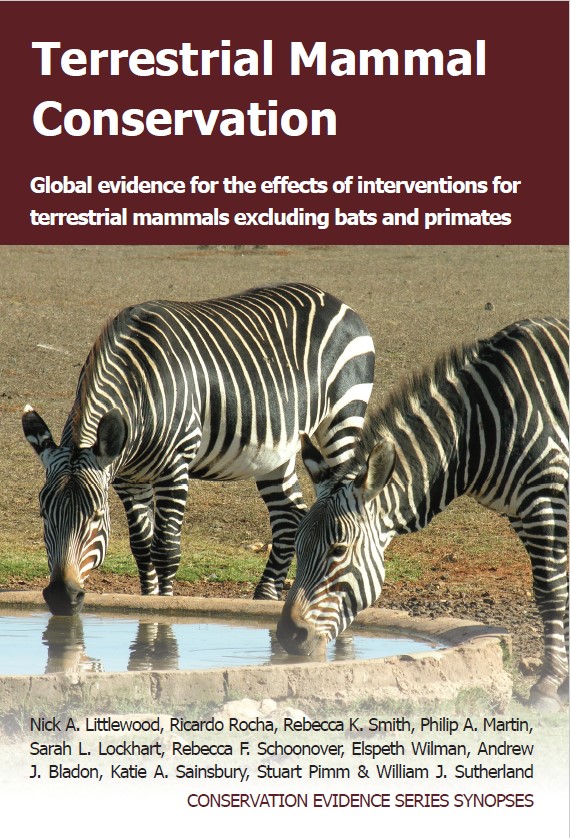Use flags to reduce predation of livestock by mammals to reduce human-wildlife conflict
-
Overall effectiveness category Likely to be beneficial
-
Number of studies: 5
View assessment score
Hide assessment score
How is the evidence assessed?
-
Effectiveness
50% -
Certainty
50% -
Harms
0%
Study locations
Supporting evidence from individual studies
A before-and-after study in 1998 of captive animals in Italy (Musiani & Visalberghi 2001) found that installing lines of flags (known as fladry) 50 cm high and ≤ 50 cm apart, deterred passage by gray wolves Canis lupus. Of 18 barrier designs trialled, four of five that were not crossed at all by two wolves involved lines of flags 50 cm high, with flags ≤50 cm apart. Three wolves in a larger enclosure made no crossings of a 50-cm-high flag line put in place to prevent access to one sixth, half and five sixths of the enclosure, even when the flag line split the enclosure in half with food placed at the opposite side. Flag lines comprised 50 × 10-cm red or grey flags. Two wolves, in a 120-m2 enclosure, regularly paced along a fenceline and barriers were set along this route. Three wolves, in an 850-m2 enclosure, were excluded from varying proportions by flag lines. In all trials, wolves were observed for 30 minutes before and 30 minutes after each flag line was installed.
Study and other actions testedA replicated, before-and-after study in 2001–2002 on two pastures in Alberta, Canada (Musiani et al. 2003) found that installing flags along fences (known as fladry) deterred wolves Canis lupus from entering pastures and predating livestock. Results were not tested for statistical significance. Before flags were installed, wolves approached pastures 2–7 times and predated livestock 2–5 times. With flags installed, wolves approached pastures 6–17 times but did not enter or predate livestock. After flags were removed, wolves approached twice and predated livestock 0–2 times. Plastic flags were placed at 50-cm intervals, suspended 50 cm above the ground on rope, 2 m out from the livestock fence. Two pastures (c.25 ha, 150 km apart) were studied. Each contained 100 cattle. Wolves were monitored by tracking signs in the snow, in winters of 2001 and 2002. Monitoring covered 60 days before flag installation, 60 days with flags installed and 60 days after flag removal.
Study and other actions testedA replicated, controlled, before-and-after study in 2002 of forest at six sites in Wisconsin, USA (Shivik et al. 2003) found that installing lines of coloured flags (known as fladry) did not reduce overall deer carcass consumption by carnivores. Before installation, average consumption did not differ between carcasses assigned to treatments (flags: 2.0 kg/day; no flags: 1.6 kg/day). After flags were installed, consumption at these plots (2.5 kg/day) did not differ significantly from that at plots with no deterrent (3.3 kg/day). Wolves Canis lupus, black bears Ursus americanus, fishers Martes pennanti and foxes Vulpes vulpes visited plots. Study plots (30-m circumference) were established within territories of each of six wolf packs. A fresh deer carcass was placed in each plot. Plots were maintained for 9–35 days pre-treatment and 16–29 days during the treatment phase. The study ran during April–June 2002. Red flagging (100 × 7.5 cm) was suspended from perimeter ropes and was used at one plot in each territory and one plot had no deterrent. Carcasses were weighed every 2–3 days and replaced as required. Camera traps at three territories identified species visiting plots.
Study and other actions testedA replicated, randomized, controlled study in 2004–2005 in eight pasture and forest sites in Michigan, USA (Davidson-Nelson & Gehring 2010) found that tying coloured flags to a fence (known as fladry) reduced visits to pastures by gray wolves Canis lupus but not by coyotes Canis latrans. Fewer wolves were found in pastures where flags were used (0.3 visits/day) than outside pastures at the same sites (1.4 visits/day). There was no significant difference in wolf visitation rates where flags were not used (inside pasture: 0.7 visits/day; outside pasture: 0.3 visits/day). With flags, there was no significant difference in frequency of coyote visits in pastures (0.4 visits/day) and outside pastures at the same site (0.7 visits/day), and the same was true when flags were not used (inside pasture: 0 visits/day; outside pasture: 0.3 visits/day). In May 2004, red nylon flags were attached to fences at four randomly selected farms. At four other farms, no flags were used. One bait station, containing sand with sheep or cattle faeces, was placed inside each pasture and one outside each pasture fence. In May–August 2004 and 2005, each bait station was checked for wolf and coyote tracks.
Study and other actions testedA replicated, randomized, controlled study in 2007 at 12 pasture sites in Montana, USA (Lance et al. 2010) found that wolves Canis lupus did not visit sites with flags hanging from an electrified fence. The result was not tested for statistical significance. Relative effects of flags and electric fences cannot be separated in this study. Grey wolves Canis lupus did not visit any pastures with flags on electrified fences but twice visited pastures with conventional barbed wire fences. However, no livestock were killed by wolves in the pastures. The study was conducted in 12 pastures (16–122 ha), each with 40–200 cows. Pastures were contained within barbed wire fences. Six pastures (randomly selected) had electrified fences with red flags (50 × 10 cm) suspended from them, positioned outside existing fences and six did not. Wolf tracks were monitored twice weekly, for three months, in 2007.
Study and other actions tested
Where has this evidence come from?
List of journals searched by synopsis
All the journals searched for all synopses
This Action forms part of the Action Synopsis:
Terrestrial Mammal Conservation
Terrestrial Mammal Conservation - Published 2020
Terrestrial Mammal Conservation





)_2023.JPG)














